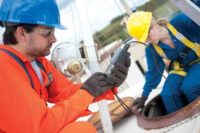Carbon monoxide poisoning symptoms, causes & treatment

Carbon monoxide poisoning occurs when carbon monoxide builds up in your bloodstream. When too much carbon monoxide is in the air, your body replaces the oxygen in your red blood cells with carbon monoxide. This can lead to serious tissue damage, or even death.
Carbon monoxide is a colorless, odorless, tasteless gas produced by burning gasoline, wood, propane, charcoal or other fuel. Improperly ventilated appliances and engines, particularly in a tightly sealed or enclosed space, may allow carbon monoxide to accumulate to dangerous levels.
If you think you or someone you're with may have carbon monoxide poisoning, get into fresh air and seek emergency medical care.
Signs and symptoms of carbon monoxide poisoning may include:
- Dull headache
- Weakness
- Dizziness
- Nausea or vomiting
- Shortness of breath
- Confusion
- Blurred vision
- Loss of consciousness
Carbon monoxide poisoning can be particularly dangerous for people who are sleeping or intoxicated. People may have irreversible brain damage or even die before anyone realizes there's a problem.
When to see a doctor
The warning signs of carbon monoxide poisoning can be subtle. But the condition is a life-threatening medical emergency. If you think you or someone you're with may have carbon monoxide poisoning, get into fresh air and seek emergency medical care.
Carbon monoxide poisoning is caused by inhaling combustion fumes. When too much carbon monoxide is in the air you're breathing, your body replaces the oxygen in your red blood cells with carbon monoxide. This prevents oxygen from reaching your tissues and organs.
Various fuel-burning appliances and engines produce carbon monoxide. The amount of carbon monoxide produced by these sources usually isn't cause for concern. But if they're used in a closed or partially closed space — cooking with a charcoal grill indoors, for example — the carbon monoxide can build to dangerous levels.
Smoke inhalation during a fire also can cause carbon monoxide poisoning.
Exposure to carbon monoxide may be particularly dangerous for:
- Unborn babies. Fetal blood cells take up carbon monoxide more readily than adult blood cells do. This makes unborn babies more susceptible to harm from carbon monoxide poisoning.
- Children. Young children take breaths more frequently than adults do, which may make them more susceptible to carbon monoxide poisoning.
- Older adults. Older people who experience carbon monoxide poisoning may be more likely to develop brain damage.
- People who have chronic heart disease. People with a history of anemia and breathing problems also are more likely to get sick from exposure to carbon monoxide.
- Those in whom carbon monoxide poisoning leads to unconsciousness. Loss of consciousness indicates more severe exposure.
Depending on the degree and length of exposure, carbon monoxide poisoning can cause:
- Permanent brain damage
- Damage to your heart, possibly leading to life-threatening cardiac complications
- Fetal death or miscarriage
- Death
Simple precautions can help prevent carbon monoxide poisoning:
Install carbon monoxide detectors. Put one in the hallway near each sleeping area in your house. Check the batteries every time you check your smoke detector batteries — at least twice a year. If the alarm sounds, leave the house and call 911 or the fire department. Carbon monoxide detectors are also available for motor homes and boats.
Open the garage door before starting your car. Never leave your car running in your garage. Be particularly cautious if you have an attached garage. Leaving your car running in a space attached to the rest of your house is never safe, even with the garage door open.
Use gas appliances as recommended. Never use a gas stove or oven to heat your home. Use portable gas camp stoves outdoors only. Use fuel-burning space heaters only when someone is awake to monitor them and doors or windows are open to provide fresh air. Don't run a generator in an enclosed space, such as the basement or garage.
Keep your fuel-burning appliances and engines properly vented. These include:
- Space heaters
- Furnaces
- Charcoal grills
- Cooking ranges
- Water heaters
- Fireplaces
- Portable generators
- Wood-burning stoves
- Car and truck engines
Ask your utility company about yearly checkups for all gas appliances, including your furnace.
If you have a fireplace, keep it in good repair. Clean your fireplace chimney and flue every year.
Keep vents and chimneys unblocked during remodeling. Check that they aren't covered by tarps or debris.
Make repairs before returning to the site of an incident. If carbon monoxide poisoning has occurred in your home, it's critical to find and repair the source of the carbon monoxide before you stay there again. Your local fire department or utility company may be able to help.
Use caution when working with solvents in a closed area. Methylene chloride, a solvent commonly found in paint and varnish removers, can break down (metabolize) into carbon monoxide when inhaled. Exposure to methylene chloride can cause carbon monoxide poisoning.
When working with solvents at home, use them only outdoors or in well-ventilated areas. Carefully read the instructions and follow the safety precautions on the label.
Source: Mayo Clinic www.mayoclinic.org
Looking for a reprint of this article?
From high-res PDFs to custom plaques, order your copy today!






